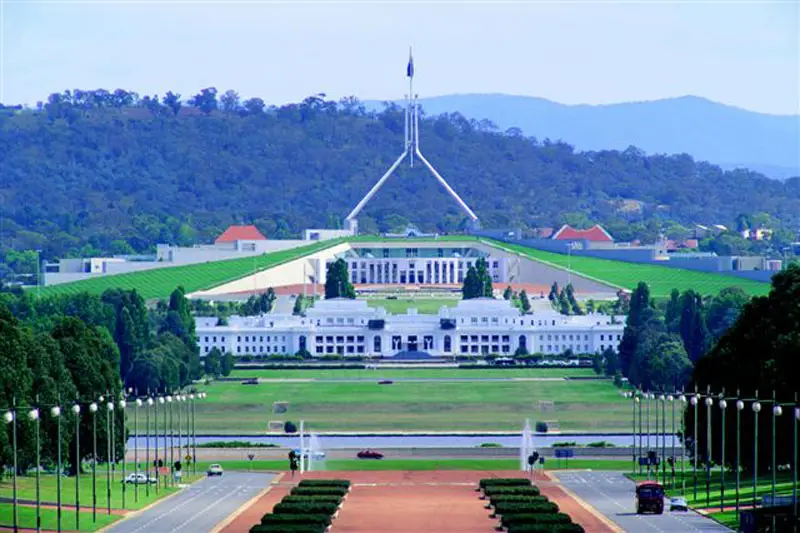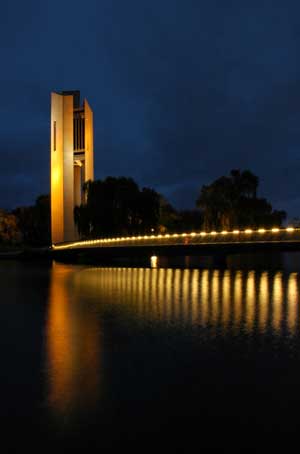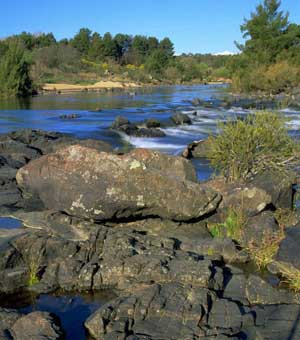
About Canberra
Australia’s capital city, Canberra is a planned city, surrounded by the mountains, farmlands and natural parks. An international competition was held to choose the best design and won by the architect Walter Burley Griffin in 1912, with building commencing the next year, though the Burley Griffin design has now been altered significantly. Griffin envisioned the city to be spacious and low level, centered on Lake Burley Griffin.
The lake itself is bordered by splendid parklands, making the city more than the political and diplomatic centre of the country, but an attraction in itself. The inner city is laid out on two major perpendicular axes, a water axis that stretches along Lake Burley Griffin, and a ceremonial land axis stretching from Parliament House on Capital Hill north-eastward to the Australian War Memorial at the foot of Mt. Ainslie. As well as the unusual road system featuring many circular streets and roundabouts, Canberra’s highly planned nature has led to a striking absence of commerce on its major trafficked streets.
The Australian Capital Territory, which is wholly surrounded by the state of New South Wales, is the site of Canberra. Australia’s largest inland city (population 322,000), Canberra is located at the northern end of the Territory near a portion of the Brindabella Ranges, approximately 150 km inland from Australia’s east coast. Being the 8th most populous city in the country, Canberra is smaller than any of the state capitals except Hobart.
It is important to remember that the city was created to be the seat of Government for the Commonwealth of Australia and the place where the thousands of public servants who work there also live. These are still its primary functions – and this is reflected in just about everything Canberra is and does and has to offer the visitor. Thus, even the attractions that are promoted to visitors as ‘must-sees’ are primarily the kind that one expects to find in a nation’s capital – things which showcase and/or symbolise the nation’s strengths, uniqueness and abilities, mixed with salutes to its people – past and present – who have contributed towards Australia being the nation it is today. If you go to Canberra expecting to see anything else – which many visitors, particularly those from overseas, tend to do – you may, like many of them, be disappointed. Many who visit Canberra say it is sterile and boring, and that is how it appears if you go there expecting it to be something other than a purpose built, working national capital. Go there knowing what it is and why it is there and it will more than meet your expectations.
When the constitution for the Commonwealth of Australia was being negotiated between the colonies, Melbourne and Sydney each wanted to become the capital. As a compromise, it was agreed that the capital would initially be Melbourne, until a new capital city could be built. In 1910 the Australian Capital Territory was ceded by act of Federal Parliament in Melbourne. The politician King O’Malley responsible for the legislation creating the ACT, also passed a law later that year making the ACT an alcohol-free area.
In 1911 an international design competition was held, which was won by American architect, Walter Burley Griffin. The official naming of Canberra and its official construction began on 12th March 1913. The Federal Government officially moved to the ACT from Melbourne on the formal opening of the Provisional Parliament House on 9th May 1927.
Canberra is located at altitudes that range from 550m to 700m above sea level. This results in temperature ranges from -5° C to 35° C. The hottest days are generally in December and January. In wintertime, the days can get very chilly, and snow falls every few years.
Canberra has four distinct seasons, unlike many other Australian cities whose climates are moderated by the sea (it is Australia’s only inland capital city). Spring (September-November) is typified by cool days, lengthening sunlight, and periodic rain. The Canberra Spring is signalled by buds and blossoms on fruit trees, flower festivals, the return of Bogong Moths from their annual migration, and the annual Floriade flower festival.
In Summer, rain ceases before Christmas and humidity is generally low until March (or even April.) The light is stark, and hats are worn outside to protect from the sun.
Autumn brings freshening days and ANZAC Day (25th April) can be quite sharply cold for those attending the dawn service at the Australian War Memorial. The leaves of the many deciduous trees such as poplars, oaks and elms turn and fall, producing a colourful spectacle each May. Rain begins again at odd intervals.
Winter is typically the season of rain, but in 2003 and 2004 drought persisted. Fog frequently occurs during winter mornings, and can cause flight delays or cancellations at Canberra International Airport.








